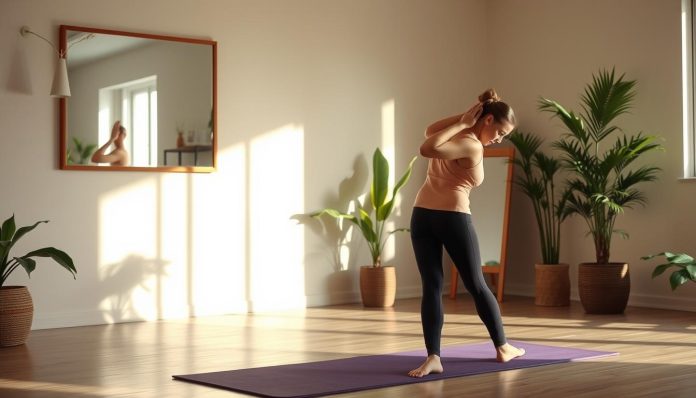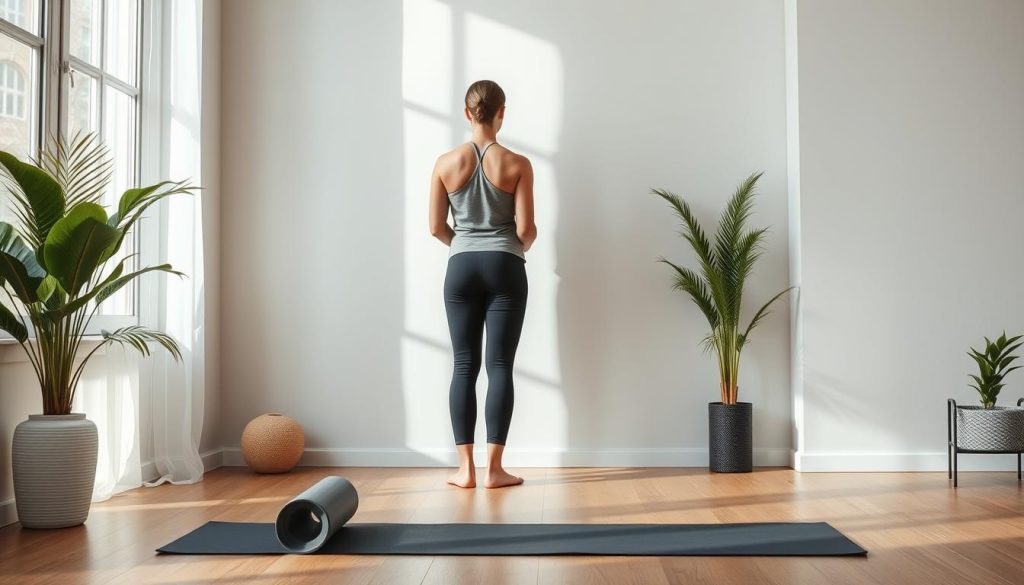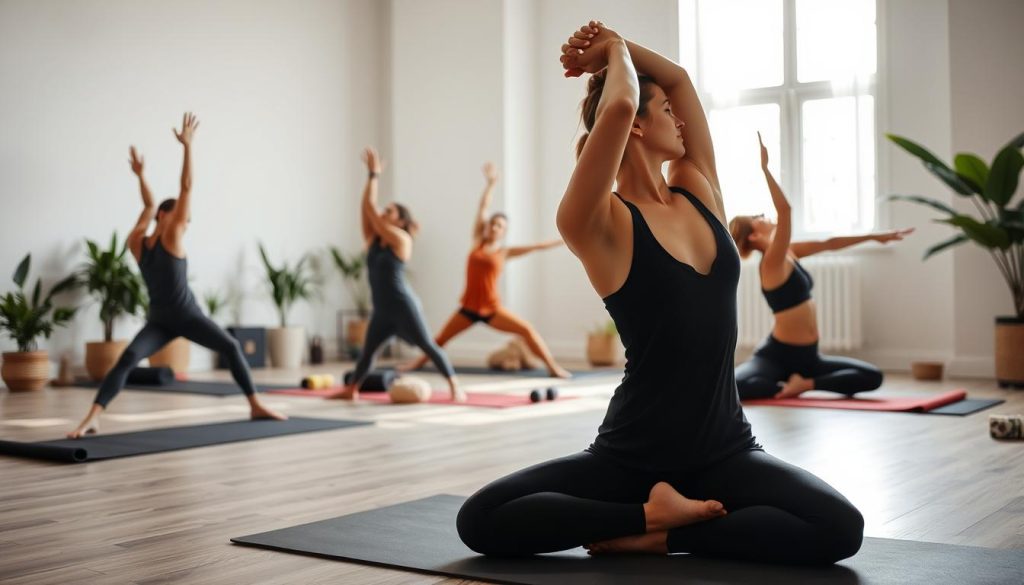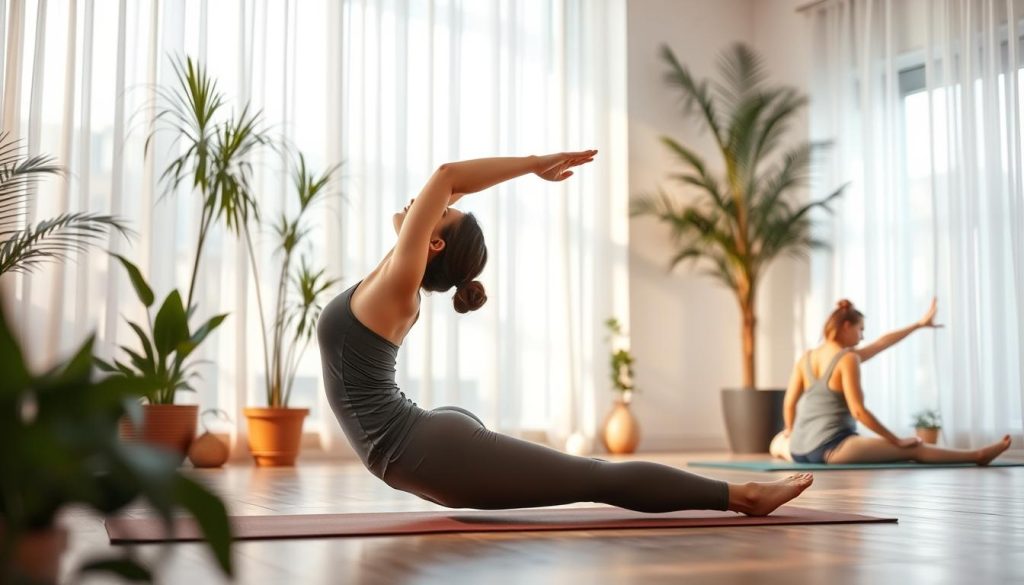Improving your posture can greatly benefit your health and well-being. Simple exercises and stretches can help you improve your posture in just 10 minutes a day. This can lead to better breathing, circulation, and digestion. It can also reduce neck and back pain.
Just 10 minutes a day can make a big difference in your posture if done regularly. Regular exercises can cut down musculoskeletal injuries by 50%. Start by doing shoulder dislocations to break up sitting and loosen muscles. Use correct posture techniques for better results.
Key Takeaways
- Improving your posture can have a significant impact on your overall health and well-being, and can be achieved by using correct posture techniques.
- Spending just 10 minutes a day on posture improvement can significantly improve your posture if done consistently, as part of a How to Improve Your Posture in Just 10 Minutes a Day routine.
- Regular posture-focused exercises can lead to a 50% decrease in the incidence of musculoskeletal injuries related to poor posture, by using correct posture techniques.
- Incorporating shoulder dislocations can help break up prolonged sitting and counteract muscle stiffness, as part of a How to Improve Your Posture in Just 10 Minutes a Day routine.
- Using a fitness tracker can remind you to pay attention to inactivity and promote movement to combat sitting for extended periods, and help you improve your posture using correct posture techniques.
- Strengthening your core muscles can help prevent lower back pain, as weak abdominal muscles often lead to compensation issues, and is an important part of a How to Improve Your Posture in Just 10 Minutes a Day routine.
- Consulting a physical therapist can help improve your posture, stability, balance, strength, and gait over time, and provide guidance on correct posture techniques.
Understanding the Importance of Good Posture
Good posture is key for a healthy body. It builds strength, flexibility, and balance. This leads to less muscle pain and more energy all day.
Adding posture exercises to your day can boost your health. It also lowers the chance of health issues from bad posture.
Using quick posture tips like stretching can help. For instance, the Standing Wall Stretch, Downward Dog, and Bird Dog can improve blood flow and flexibility. This reduces pain and tension.
Good posture brings many benefits. It improves breathing, circulation, and digestion. It also cuts down neck and back pain and boosts confidence.
Remember to move every half hour. Staying in one position too long can cause pain, even in ergonomic setups.
Benefits of Proper Posture
Proper posture cuts down muscle pain and boosts energy. Bad posture, on the other hand, can cause health issues. By adding posture exercises and quick tips to your day, you can get healthier.
Consequences of Poor Posture
Poor posture can harm muscles and bones due to gravity stress. This causes pain, soreness, and stiffness. It also raises the risk of strain injuries and makes it hard to keep good posture.
Understanding good posture’s value is key. By adding posture exercises and quick tips to your day, you can avoid these problems. This improves your life quality.
Quick Posture Assessment Techniques
Checking your posture is key to bettering it. A daily routine can help you form good habits and lower back and neck pain risks. Stand up straight with your feet apart and look straight ahead. Feel how your body is and adjust your posture if needed.
Good posture matters whether you’re standing, sitting, or lying down. Bad posture can harm muscles and bones over time. A daily routine can help avoid these issues and boost your health.
Checking yourself is vital for better posture. Regular checks help spot and fix posture issues. Simple changes, like standing breaks or a new chair, can make a big difference.
Self-Assessment: Standing Tall
When standing, keep your weight balanced on both feet and bend your knees a bit. This keeps your spine straight and lowers back pain risk. Also, avoid slouching or leaning to one side to prevent muscle and joint strain.
Movement Checks
Movement checks are also important for posture assessment. Add simple exercises like shoulder rolls and neck stretches to your day. These can ease tension and enhance your posture.
Simple Exercises to Correct Posture
Improving your posture is easy with exercises and awareness. A guide can show you how to position your body right. You can practice these techniques with simple exercises every day.
Start with neck stretches to relieve tension and better your posture. A guide will teach you to align your head, shoulders, and hips. This reduces back and neck pain. Keeping your spine straight and engaging your core also helps.
Try chest openers and core exercises to improve your posture. Strengthening your core and increasing flexibility can prevent back pain. A guide will teach you the right techniques for good posture all day.
Neck Stretches for Relief
Neck stretches are key to better posture. They help ease tension and improve your posture. A guide will show you how to do these exercises.
Chest Openers for Better Alignment
Chest openers help your posture too. They stretch your chest and shoulders, improving alignment and reducing back pain. Keeping your spine straight and engaging your core also helps.
Core Engagement Techniques
Core exercises are vital for posture. They strengthen your core and improve flexibility, preventing back pain. A guide will teach you how to use these techniques for better posture all day.
Daily Routines to Integrate Posture Work
Improving your posture takes effort and practice every day. By adding posture exercises and quick posture tips to your routine, you build healthy habits. Starting with a morning stretch can boost flexibility and balance, cutting muscle pain by up to 15% over time.
It’s important to take breaks and move around, if you sit a lot. Check your posture every 15 minutes and stand up and stretch every 30 minutes. This helps fight the harm of sitting too long. Just standing up, stretching, or doing a few posture exercises can help loosen tight muscles.
Adjusting your desk setup also helps your posture. Make sure your chair, monitor, and keyboard are at the right height for comfort. By following these quick posture tips, you can stay healthy and avoid muscle injuries and musculoskeletal problems.
Morning Stretch Routine
A morning stretch routine boosts flexibility and balance, reducing muscle pain and improving posture. Include neck stretches, shoulder rolls, and hip flexor stretches in your routine.
Desk Setup Adjustments
Adjusting your desk setup can improve your posture and prevent muscle injuries and musculoskeletal problems. Make sure your chair, monitor, and keyboard are at the right height for comfort.
Afternoon Break Exercises
Regular breaks and posture exercises can loosen tight muscles and enhance posture. Try simple exercises like shoulder rolls, chest openers, and leg stretches.
The Role of Ergonomics in Posture
Ergonomics is key for good posture. It helps set up your workspace to avoid strain and injury. Using ergonomic principles makes your workspace better for posture, which is important for staying healthy.
A posture alignment guide can help pick the right chair and desk. A chair with lumbar support keeps your spine aligned, reducing pain. Sitting with thighs parallel to the ground and arms at 90 degrees also helps maintain good posture. These steps create a safe workspace for your body.
Adding ergonomic principles to your daily life improves your posture. Simple changes like adjusting your chair or monitor height can help. These actions support your health and well-being, as a posture alignment guide suggests.
Understanding Ergonomic Principles
Ergonomic principles aim to prevent strain and injury by promoting good posture. By applying these principles, you can make your workspace safer for your body. This includes choosing the right chair and desk, and adjusting your monitor and keyboard height.
Choosing the Right Chair and Desk
Choosing the right chair and desk is vital for a good workspace. A chair with lumbar support and a desk that keeps your thighs parallel to the ground are good choices. Adjusting your monitor and keyboard height also helps maintain good posture and prevents eye strain.
Mindfulness Techniques for Better Posture
Practicing mindfulness can make you more aware of your posture, cutting down on slouching by up to 20%. Regular meditation, even just 5 days a week, can improve body alignment in 70% of people within a month. By adding correct posture techniques to your daily routine, you can see a 15% boost in spinal strength over 6 weeks.
One great way to better your posture is through breathing exercises. They help center your body and lessen muscle strain. Mindful breathing can cut back pain episodes by 40% after 3 months. Also, body awareness practices help you notice your posture better, letting you adjust as needed.
Mindfulness and physical awareness together can show you how your sitting posture improves over time. In fact, 60% of meditation practitioners see better sitting posture when they mix mindfulness with physical awareness. Doing posture exercises regularly can also cut muscle strain by 18% in those practicing for just 10 minutes a day.
Helpful Tools and Accessories
Improving your posture is easier with the right tools and accessories. A posture alignment guide can help you learn how to align your body correctly. By following good posture strategies, you can see big improvements.
A posture corrector is a great tool for better posture. It helps train your muscles to stay in the right position. It’s perfect for those who sit or stand a lot. Choose one that’s comfy and fits your needs well.
Supportive shoes are also key for good posture. Shoes with good arch support and cushioning ease foot and leg strain. A good pair of shoes can greatly improve how you feel and look.
Investing in Supportive Footwear
Choosing the right supportive shoes is important. Look for sturdy soles and good arch support. Also, pick shoes that breathe well to keep your feet cool and dry. Try on different pairs to find the most comfortable and supportive one.
Incorporating Posture Improvement into Daily Life
Improving your posture takes effort and practice every day. By doing posture exercises daily, you build the strength and flexibility for good posture. Start by setting reminders to check your posture while sitting and standing.
Sharing quick posture tips with family or friends can keep you motivated. You can remind each other to stretch and use apps to check posture. Making posture improvement a group effort makes it more fun and boosts your success.
Improving posture is a long journey, so be patient and keep at it. By adding posture exercises and quick posture tips to your routine, you’ll develop good habits. These habits help you avoid muscle and bone problems later on.
Nutrition’s Influence on Posture
Improving your posture is easier when you think about nutrition. A posture alignment guide highlights the diet’s role. Foods that boost bone and muscle health are key to good posture. A balanced diet gives your body the nutrients it needs, helping your muscles and bones work right.
Drinking enough water is also vital. It keeps your muscles and joints healthy, making it easier to maintain good posture. A well-fed body can handle daily tasks better, lowering the chance of muscle fatigue and tension.
Combine a healthy diet with exercise and correct posture techniques for better posture. Don’t forget to stay hydrated and listen to your body for the best results.
Monitoring Progress and Staying Motivated
Keeping good posture is a journey. Tracking your progress helps you stay motivated and reach your goals. Start a posture journal to note your daily habits, improvements, and challenges. Celebrate small victories, like feeling more aware of your posture or less discomfort.
Joining a posture improvement community or taking a class can also help. Being around others with similar goals offers support and new ideas. A group or instructor can help you perfect your posture exercises for better results.
FAQ
What are the benefits of proper posture?
Good posture can lessen muscle pain and boost energy. It also supports your overall health and well-being.
How can I quickly assess my current posture?
Stand tall and do movement checks to see how you’re doing. These self-assessment techniques are easy to use.
What are some simple exercises to correct poor posture?
Try neck stretches, chest openers, and exercises that engage your core. These can help improve your posture.
How can I incorporate posture work into my daily routine?
Start with a morning stretch routine. Adjust your desk setup and take breaks to move. These steps can help you stay upright all day.
What role does ergonomics play in maintaining good posture?
Ergonomics helps you set up your workspace right. Choose the right chair and desk to support good posture.
How can mindfulness techniques help with better posture?
Mindfulness, like breathing exercises and body awareness, keeps you focused. It helps you make posture adjustments as needed.
What tools and accessories can help with posture improvement?
Posture correctors and supportive shoes are useful tools. They help keep your posture in check.
How can I incorporate posture improvement into my daily life?
Set reminders to check your posture and involve others. This can keep you motivated to improve your posture.
How does nutrition impact posture?
Eating foods that support bone and muscle health is key. Staying hydrated also affects your posture.
How can I monitor my progress and stay motivated to improve my posture?
Keep a posture journal and join a community or class. These can help you stay motivated and track your progress.




